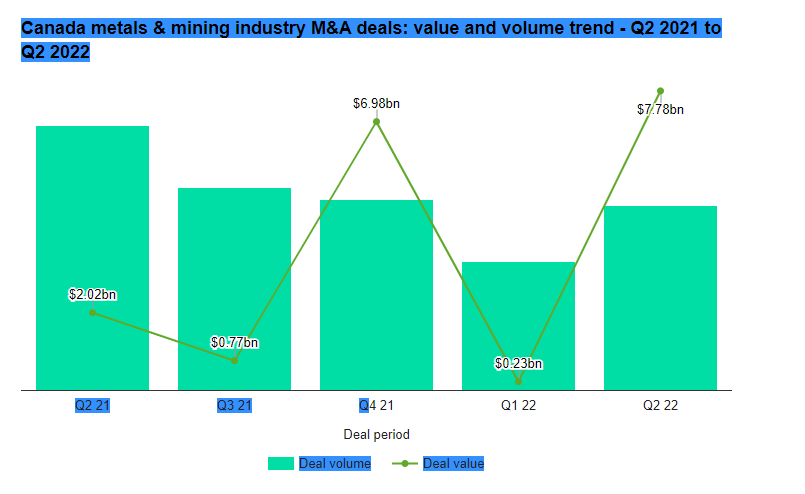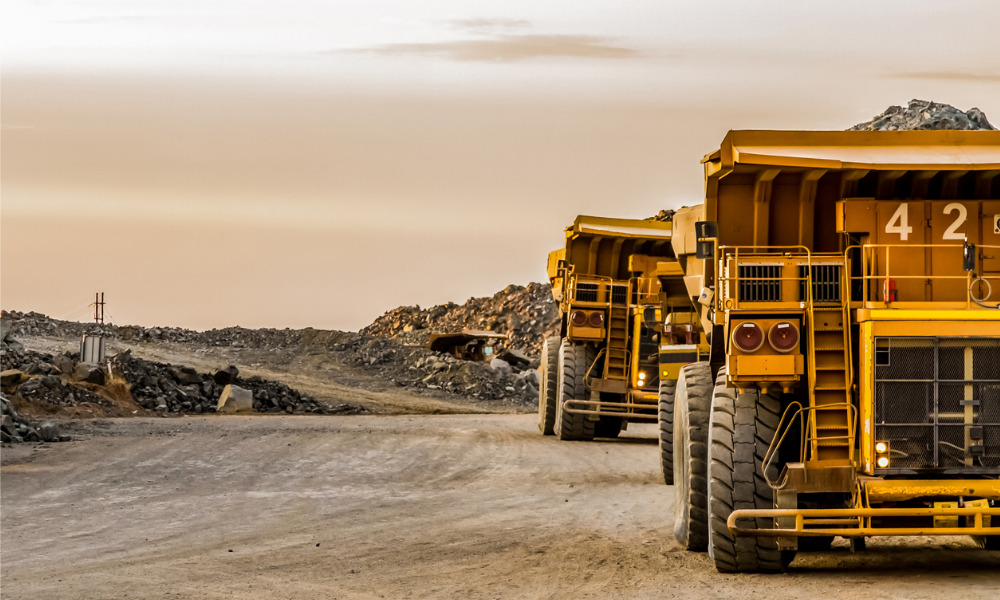Market volatility and uncertainty about the economy will impact dealmaking in the mining sector. But lawyers who work with mining companies and their investors say that the deal flow is still there and will come back even more once transparency improves.
“There is still activity in M&A even during this period of volatility,” says John Wilkin, a partner in the securities group at Blake Cassels & Graydon LLP. “But the type of transactions we’re seeing is changing.”
In 2021, he says, the story was very much base metals, such as copper, and so-called strategic metals like rare earth minerals and lithium.
However, in 2022, the interest is more in precious metals like gold and silver. Wilkin says that despite the price of these metals coming off recent highs, they are “still maintaining their relative strength compared to base metals.”
Volatility in dealmaking
Wilkin points out that current volatility has made it somewhat difficult for boards of mining companies to make deals or want to make deals. “It’s challenging for boards to complete transactions if there are rapid changes in the price of metals,” he says, adding, “They are still looking for opportunities, but their execution is a bit more difficult.”
Once volatility settles down, he says, one way or the other, those wanting to make deals “will get a better line of sight.”
Many deals use a combination of cash and stock as currency. However, the number of acquisitions that require leveraged debt financing has recently decreased, Wilkin says, with the increased cost of capital. “Transactions that can be done using stock, or a combination of stock and cash, are more likely to get done.”
Despite some slowdowns, however, deals are still happening. Wilkin points to acquisitions that have recently closed, such as Skeena Resources’ purchase of QuestEx Gold & Copper, then selling certain QuestEx properties to an affiliate of Newmont Corporation. Also, American silver producer Hecla Mining has agreed to acquire all the shares of Canada’s Alexco Resource that it doesn’t already own in an all-stock deal valued at more than US$75 million. That deal was expected to close in September.
Consolidation in the gold market
At Stikeman Elliott LLP, Amanda Linett, a partner and co-head of the firm’s mining group, notes that much of the consolidation in the gold sector comes from already-large players wanting to replace depleting reserves and benefit from economies of scale.
A recent 2022 example Linett points to follows on the heels of the 2019 merger of Randgold Resources Ltd. and Barrick Gold Corp. into Barrick Gold (Holdings) Ltd. as well as Newmont Mining Corp.’s 2019 acquisition of Goldcorp Inc. Her example is the $22-billion “merger of equals” between Agnico Eagle Mines Ltd. and Kirkland Lake Gold. The deal, which closed in February, establishes Agnico Eagle as the third-largest gold company in the world and the largest producer of gold mined in Canada.
While a lot of M&A will focus on targets with quality production assets, Linett says, “Buyers are on the lookout for acquiring development projects, companies that have promising assets not yet developed and even exploration companies that won’t likely produce for a number of years.”
Jen Hansen, a partner in the securities group at Cassels Brock and Blackwell LLP, also notices that “capital markets seem to be in a bit of a lull on the financing side, whereas with M&A activity, we’re still seeing a fairly active market. We expect that to endure, and we anticipate that we will continue to see strategic transactions and consolidation in the sector, even in light of the challenging capital markets, as there are opportunities that remain. Though, given the market reaction to a number of recent transactions, we will likely see issuers exercising discipline in their approach, along with ongoing, enhanced engagement with stakeholders as to the rationale.”
Some proposed deals have faced pushback. For example, Gold Fields’ intended acquisition of Canada’s Yamana Gold remains in limbo. However, the South African miner is gaining backers for its purchase as shareholders better understand the company’s strategy, which includes consolidation and expanding to offset rising costs.
Since the parties announced the deal on May 31, Gold Fields has lost about a third of its value and Yamana 15 percent, leaving the Canadian gold target with a market capitalization of $4.4 billion, compared to the $6.7 billion it had in May.
Gold Fields improved the original bid in early July to ease investors’ concerns by offering to pay shareholders 30 to 45 percent of normalized earnings at the interim and final dividend stages, up from a previous payout range of 25 to 35 percent. It also promised a 45-percent payout for the 2023 interim and final dividends after it completes the friendly acquisition.
Still, even Gold Fields CEO Chris Griffith has admitted he’s not sure whether the company will obtain 75 percent of the votes needed to go ahead with the deal. Since the Johannesburg-based miner approached its target, shareholders have criticized the proposed all-stock merger, arguing the friendly approach does not guarantee growth and profitability.
Gold Field’s proposed acquisition with Yamana was the largest of the five metals and mining industry M&A deals of Q2 2022 tracked by GlobalData. The others were:
- the $646.37 million acquisition of Nomad Royalty by Sandstorm Gold
- Orla Mining’s $189.23 million acquisition deal with Gold Standard Ventures
- Uranium Energy’s $161.59 million acquisition of UEX
- the $33.67 million acquisition of a 25.2 percent stake in Entrée Resources by 1363013 BC, a wholly owned subsidiary of Royalty North Partners
Sander Grieve, head of the mining industry team at Bennett Jones LLP, says there is still some “tire kicking” in the mining marketplace, despite caution among potential buyers and sellers holding back due to an expected price rebound.
“Some of the pressure has come off price,” he acknowledges, but “there’s also the expectation that this is a temporary effect of where we are right now, which seems to be an inflation story,” says Grieve.
Rising demand for critical minerals
In the long term, the “demand is there” for critical minerals, along with base metal components needed to feed the growing interest in decarbonization and electrification in sectors such as the auto industry, says Grieve.
“If you looked at the recent flagging prices of copper and nickel, key components in electrification, you’d think that no one was going ever to drive an electric car,” he says. However, this isn’t likely to be the case. And indeed, while nickel prices are slumping, copper prices have rebounded somewhat from this year’s lower prices.
“There are a lot of people who will sit on the sidelines now and watch to see how things settle out before they’re going to instigate a deal or accept these current valuations,” he says. “You might see a bit of an M&A slowdown, but that will change, as there are deals that must be done and people who will see opportunity.”
Jason Saltzman and Leanne Krawchuk at Dentons Canada also note the growing importance of metals such as copper and critical minerals to mining companies like Teck Resources as it strives to focus more on environmental sustainability. Teck mines for commodities such as coal for the steelmaking industry, copper, and zinc, but retiring CEO Don Lindsay recently said it would be placing a higher emphasis on projects related to the green economy.
Says Krawchuk: “Companies like Teck are balancing their portfolios. So that may mean divestitures of oil and gas, thermal coal, any asset where they say they’ve got to reduce or change.”
Teck announced the NewRange Copper Nickel joint venture with PolyMet Mining to develop projects in Minnesota in the quest for critical minerals. One option the company is exploring is spinning out its 21.3-percent stake in the Fort Hills project in northern Alberta’s oil sands. (Calgary-based Suncor Energy Inc. is the operator of Fort Hills and owns a 54.1-percent stake, while TotalEnergies SE of France has a 24.6-percent interest.)
Other companies have used M&A to gain more exposure to critical minerals. For example, earlier this year, Australia’s Rio Tinto completed the US$825-million acquisition of the Rincon lithium project in Argentina from Rincon Mining, a company owned by private equity group Sentient Equity Partners. In addition, Canada’s Capstone Mining agreed to merge with Chile-focused Mantos Copper to create a copper producer focused on the Americas.
Saltzman says potential purchasers for many critical resources may not all be traditional buyers, such as other mining companies. Manufacturers such as car companies may want materials essential to building the batteries that power electric cars.
For instance, Talon Metals, through its US subsidiary Talon Nickel, recently entered an agreement with Tesla to supply and purchase nickel concentrate to be produced from the Tamarack Nickel Project in Aitkin County, Minnesota. This agreement is the start of an innovative partnership between Tesla and Talon for the responsible production of battery materials directly from the mine to the battery cathode.
“When I first heard about the idea, I was scratching my head a bit, wondering if I understood. Isn’t this a mining company and Tesla this big electric car company?” says Saltzman. “But if you think about it, it makes a lot of sense – car companies need these materials, so having an offtake agreement can help guarantee a stable supply.”
Adds Saltzman: “From an M&A perspective, the need and demand for critical minerals bring some interesting parties to the table as potential suitors.”
Canada metals and mining M&A deals – Q2 2021 to Q2 2022 
For Q2 2021 put the number 43 within blue bar (number of deals)
For Q3 2021 put the number 33 within blue bar (number of deals)
For Q4 2021 put the number 31 within blue bar (number of deals)
For Q1 2022 put the number 21 within blue bar (number of deals)
For Q2 2022 put the number 30 within blue bar (number of deals)
Source: GlobalData’s deals database





